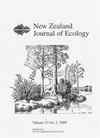设计不良的生物多样性损失-收益模型促进了新西兰生物多样性的丧失
IF 1.4
3区 环境科学与生态学
Q3 ECOLOGY
引用次数: 0
摘要
本文章由计算机程序翻译,如有差异,请以英文原文为准。
Poorly designed biodiversity loss-gain models facilitate biodiversity loss in New Zealand
: Biodiversity offsetting and compensation proposals are routinely employed through the resource consenting process to address development-induced indigenous biodiversity losses in Aotearoa/New Zealand. Determining the quantum of demonstrable biodiversity gain required to adequately account for development induced losses is a fundamental component of designing a biodiversity offset. However, trading biodiversity is complex and must account for substantial uncertainties. Therefore, biodiversity offset models that account for losses and gains are a necessary tool for determining the adequacy of an offset proposal. Yet there is currently no accepted standard approach to loss-gain calculations. Models of insufficient ecological and mathematical robustness can perpetuate systematic biodiversity losses and distract decision-makers from discussions regarding real-world ecological consequences of development. We discuss these issues and present a case study to demonstrate how poorly designed biodiversity models that are currently in use in Aotearoa/New Zealand facilitate biodiversity loss. Model development and implementation has been hampered by a tension between competing requirements: (1) simple models that are user-friendly and not resource intensive to parameterise, and (2) models that are sufficiently complex to represent ecological values at an appropriate resolution. It is imperative that newly developed models adhere to standards employed in other ecological modelling domains to curb current and future biodiversity loss. Ecological practitioners and decision-makers are often unable to assess the quality of models and a lack of guidance and oversight of biodiversity offset modelling by the wider ecological and academic community is evident. We conclude that biodiversity offset modelling is a critical research area and that advancements within this space are urgently needed to halt ongoing biodiversity declines.
求助全文
通过发布文献求助,成功后即可免费获取论文全文。
去求助
来源期刊

New Zealand Journal of Ecology
环境科学-生态学
CiteScore
3.00
自引率
12.50%
发文量
35
审稿时长
>36 weeks
期刊介绍:
The New Zealand Journal of Ecology is a biannual peer-reviewed journal publishing ecological research relevant to New Zealand/Aotearoa and the South Pacific. It has been published since 1952 (as a 1952 issue of New Zealand Science Review and as the Proceedings of the New Zealand Ecological Society until 1977). The Journal is published by the New Zealand Ecological Society (Inc.), and is covered by Current Contents/Agriculture, Biology and Environmental Science, GEOBASE, and Geo Abstracts.
 求助内容:
求助内容: 应助结果提醒方式:
应助结果提醒方式:


